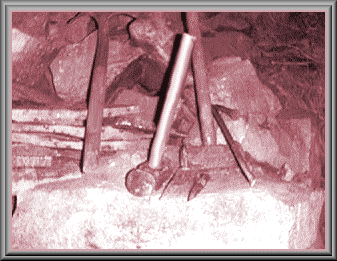|
Quarrying
and Tradition
"The
quartzite is the world’s second hardest rock. Fortunately,
there are numerous cracks and seams in the quartzite."
- Chuck Derby
Tradition
to us means that which has been handed down through the generations
or through a culture. In the case of the Pipestone quarriers,
most of us have had the tradition, that is cultural, handed
down to us thru our family.
Quarrying
for the Sacred red stone, Catlinite, is a dying occupation.
It is very hard to find people who are dedicated to the old
ways and who will work for basically nothing to keep the Pipe
alive. There are very few quarriers today and the majority
of those live in Pipestone and carry on the traditions of
their family who have been birthing the Catlinite for at least
6 generation, since prior to 1862..
"I
would go to my father's quarry where we spent so many hours
each fall, the north half of the Spotted Quarry. I often stopped
for a while and would toss out some of the smaller rocks that
had been thrown into the pit or had slid down from the debris
pilings." - Chuck Derby
We
respect the tradition and we respect what the Pipe stands
for. Sometimes we are told that we are doing wrong by our
own people, they say we are disrespectful of the Pipe. We
say that we were the ones that kept the Pipe alive during
the time ceremony was banned by the government. We continued
during that time to quarry and make Pipes and other articles
so that when the ban was lifted in 1976, we knew how to quarry
and reach the Catlinite for the many Pipes that were needed
for prayer, and we knew how to carve the stone. We continue
that Tradition today.
The
way to reach the stone is hard and can be dangerous. It is
thankless work and very tedious. However the rewards are in
the knowledge that you are working with something so sacred;
the energies of the ancient quarries, and that without you
a timeless spiritual tradition would be gone. We
all believe that to shed our sweat and blood to reach the
Sacred stone and to touch something that has been asleep under
the quartzite for many millennium - allowing that sleeping
entity to awaken by our hands - is a great honor.
"Quarrying
for pipestone is a labor intensive and time consuming task.
The proverbial phrase, ‘Sweat, blood and tears’ would be appropriate
for this endeavor." - Chuck Derby
We
would like young Native people to acquire a better knowledge
of this ancient tradition that is so sacred to many Tribes
around the land. They
may be on a reservation, or they may be in a big city, living
like the rest of America, trying to make enough to keep their
head above water. However the one thing they have in common
is their heritage and their ancestors watching them from afar.
If
you are one of these young people or you know someone who
would be interested in learning this tradition please contact
us we will be only to happy to teach the way of reaching the
sacred red stone. Once the older generation of quarriers have
passed on there will be very few who will be able to reach
the Catlinite, no stone - no pipes - no ceremonies.
"Our
ancestors would have encountered the same process and tasks
as the modern quarrier does." -
Chuck Derby
The
younger generation are urgently needed to continue this traditional
work. We hope that we can find enough people to train with
our traditional quarriers before they have passed on thus
leaving a void that no-one can fill, with the learning lost
forever. This has to be done now.
Young
people are needed to birth the sacred Catlinite so that pipes
can continue to be made of this traditional stone.
"A
physical description of how the sacred red stone lies in earth
and quartzite rock would best be described as the vein of
pipestone which is sandwiched between layers of quartzite
rock" - Chuck Derby.*

The tools used to quarry Catlinite
*All
excerpts by Chuck Derby are from his book 'Memories of
Sacred Land - Contemporary History
of the Pipestone Quarry '
|


